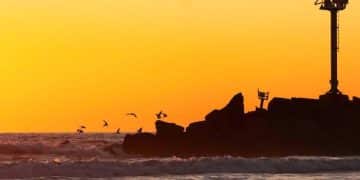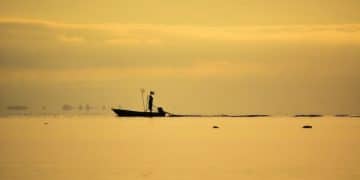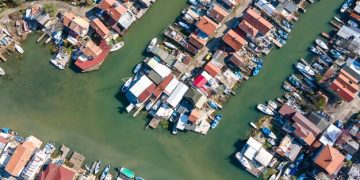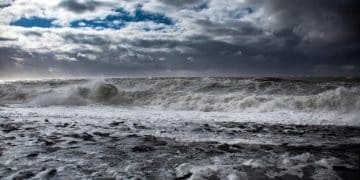Coastal Ecosystems & Climate Change: A 2025 Assessment
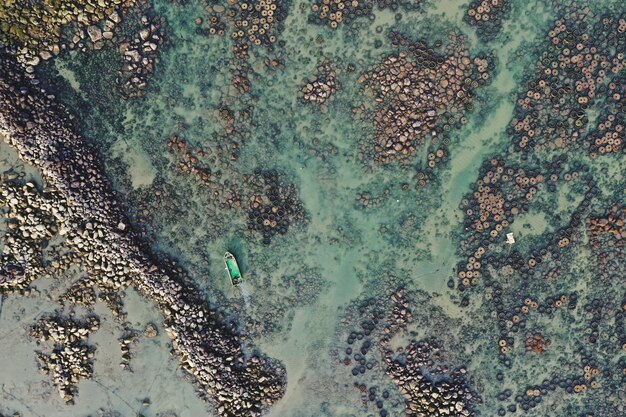
A 2025 assessment of the impact of climate change on coastal ecosystems reveals escalating threats, including sea-level rise, ocean acidification, and extreme weather, necessitating urgent, integrated conservation and adaptation strategies to protect biodiversity and human communities.
The intricate balance of our planet’s coastal ecosystems faces an unprecedented challenge as we approach 2025. Understanding the impact of climate change on coastal ecosystems: a 2025 assessment is crucial for shaping effective mitigation and adaptation strategies.
The Accelerating Pace of Sea-Level Rise and Its Coastal Toll
Coastal regions are dynamic interfaces between land and sea, but their resilience is being severely tested by global climate change. One of the most immediate and visible threats is the accelerating pace of sea-level rise, a direct consequence of thermal expansion of ocean water and melting glaciers and ice sheets.
The implications of this rise extend far beyond simple land loss. It reshapes coastlines, infiltrates freshwater aquifers, and exacerbates storm surge impacts, profoundly affecting both natural ecosystems and human infrastructure. As we assess the situation in 2025, it’s clear that many low-lying coastal areas are already experiencing tangible shifts.
Erosion and Habitat Loss
Sea-level rise amplifies coastal erosion, relentlessly gnawing away at beaches, dunes, and cliffs. This process is complex, influenced by sediment supply, wave action, and local geological conditions, yet the overarching trajectory points towards significant landward retreat.
- Beach Narrowing: Iconic sandy beaches, vital for tourism and coastal protection, are becoming narrower or disappearing entirely.
- Dune Degradation: Natural dune systems, which act as crucial storm buffers, are unable to migrate inland fast enough to keep pace.
- Cliff Retreat: Unstable coastal cliffs are eroding at accelerated rates, posing risks to properties and infrastructure perched above.
Beyond the physical loss of land, these changes translate directly into habitat destruction. Species that depend on specific tidal zones or intertidal habitats, such as nesting sea turtles or shorebirds, find their critical breeding and feeding grounds diminishing.
Saltwater Intrusion and Ecosystem Shift
As sea levels rise, saltwater infiltrates freshwater ecosystems further inland. This intrusion impacts estuaries, wetlands, and even coastal aquifers, rendering them unsuitable for species adapted to freshwater or brackish conditions. The delicate ecological balance is disrupted, favoring salt-tolerant species and potentially leading to significant biodiversity loss.
In mangrove forests and salt marshes, a phenomenon known as “coastal squeeze” occurs. As sea levels rise, these vital habitats are trapped between the encroaching sea and static human development or natural barriers, limiting their ability to migrate inland. This constriction prevents their natural adaptation and ultimately leads to their demise, removing critical breeding grounds and carbon sinks.
The 2025 assessment shows that the rate of saltwater intrusion is often underestimated in its long-term ecological and economic impacts. From agriculture to freshwater supply for human consumption, the ripple effects are pervasive and demand immediate attention.
Ocean Acidification: A Silent Threat to Marine Life
While often overshadowed by more visible climate impacts like sea-level rise, ocean acidification presents an equally dire threat to coastal and marine ecosystems. It stems from the ocean’s absorption of increasing amounts of atmospheric carbon dioxide, leading to a decrease in seawater pH and a rise in acidity.
This chemical change has profound implications, particularly for marine organisms that rely on calcium carbonate to build their shells and skeletons. Coral reefs, shellfish, and certain planktonic species are at extreme risk, posing a cascading threat through the marine food web. The impact in 2025 is already visible in some regions, with observable signs of stress and reduced calcification.
Impact on Coral Reefs
Coral reefs are often called the “rainforests of the sea” due to their immense biodiversity and ecological importance. They provide habitat, protection, and food for countless marine species, support fisheries, and buffer coastlines from storms. However, they are highly sensitive to changes in ocean chemistry.
- Reduced Calcification: Increased acidity makes it harder for corals to extract calcium carbonate from the water, inhibiting their growth and repair.
- Coral Bleaching: While primarily caused by rising ocean temperatures, acidification exacerbates coral stress, making them more susceptible to bleaching events.
- Structural Weakening: Existing coral structures become more fragile, making them vulnerable to physical damage from waves and storms.
The degradation of coral reefs has far-reaching consequences, reducing fish populations, impacting coastal protection, and jeopardizing the livelihoods of communities dependent on these ecosystems for tourism and fishing.
Threats to Shellfish and Other Calcifiers
Beyond corals, a wide array of marine organisms, including oysters, clams, mussels, and various planktonic species, are vulnerable to ocean acidification. These creatures form the base of many marine food webs, and their decline would have systemic effects on fisheries and ecosystem health.
Larval stages of many marine invertebrates are particularly susceptible to acidification, as they are actively calcifying at these early life stages. A reduction in successful reproduction cycles could lead to long-term population declines, impacting commercial fisheries and the intricate balance of marine ecosystems.
The 2025 outlook reveals a growing concern for these foundational species, with some oyster farms already reporting challenges in shell formation and increased mortality rates directly linked to changing ocean chemistry.
Extreme Weather Events: Reshaping Coastal Dynamics
Climate change is not only driving gradual shifts but also intensifying the frequency and severity of extreme weather events. Coastal areas, already vulnerable, bear the brunt of these changes, experiencing more powerful storms, increased rainfall, and prolonged heatwaves. These events act as acute shocks, causing immediate and widespread damage, and pushing ecosystems beyond their natural recovery limits.
From stronger tropical cyclones to more intense coastal flooding, the infrastructure and natural defenses of coastal regions are being severely tested. The 2025 assessment highlights a trend of rising economic losses and increased ecological disruption directly attributable to these climatological extremes.
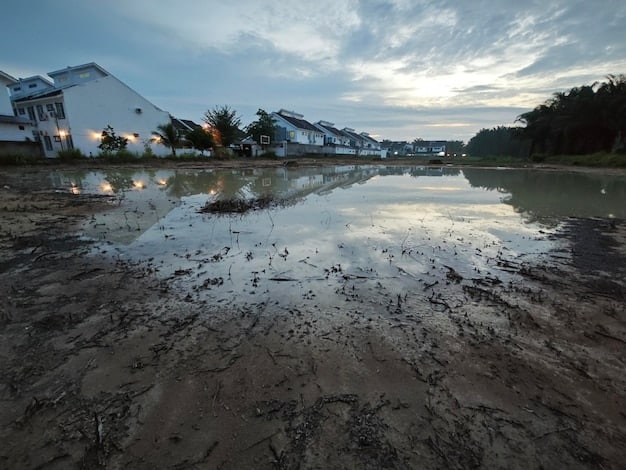
Intensified Storm Surges and Flooding
Warmer ocean temperatures fuel stronger tropical cyclones and hurricanes, leading to more intense storm surges. These surges, combined with higher sea levels, penetrate further inland, causing extensive flooding, saltwater inundation, and severe erosion.
- Infrastructure Damage: Roads, buildings, and critical infrastructure in coastal communities are increasingly vulnerable to damage and destruction.
- Habitat Destruction: Coastal wetlands, dunes, and barrier islands, which provide natural protection, are overwhelmed and degrade during severe storm events.
- Ecosystem Salinization: Freshwater coastal ecosystems are inundated with saltwater, leading to species die-offs and long-term ecological shifts.
The cumulative effect of these intensified storm surges is a significant reduction in coastal resilience, demanding more robust and adaptive planning for coastal development and environmental management.
Heatwaves and Ecosystem Stress
Marine heatwaves, prolonged periods of abnormally warm ocean temperatures, are becoming more frequent and intense. These events have devastating effects on temperature-sensitive marine organisms, particularly corals and kelp forests.
Coral bleaching, where corals expel their symbiotic algae due to heat stress, can lead to widespread coral mortality if temperatures remain elevated for too long. Similarly, kelp forests, crucial habitats and carbon sinks, are dying off in unprecedented numbers during marine heatwaves. The loss of these foundational species disrupts entire ecosystems, impacting biodiversity and the ecological services they provide.
The 2025 data indicates that these heat stress events are not isolated occurrences but are becoming a regular feature in many coastal waters, signaling a dire need for interventions that go beyond localized solutions.
Biodiversity Loss and Ecosystem Collapse
The combined impacts of sea-level rise, ocean acidification, and extreme weather events are accelerating biodiversity loss in coastal ecosystems. Species are struggling to adapt to rapidly changing conditions, leading to population declines, ecosystem shifts, and, in some cases, local extinctions. This loss of biodiversity weakens the resilience of entire ecosystems, making them even more vulnerable to future environmental changes.
The intricate web of life that characterizes coastal environments is unraveling. From microscopic plankton to apex predators, every trophic level is affected, creating a domino effect that could lead to widespread ecosystem collapse. The critical assessment in 2025 points to several highly threatened groups and habitats.
Threatened Species and Shifting Ranges
Many coastal species are highly specialized and have narrow environmental tolerances. As their habitats are degraded or disappear, they face immense pressure. This pressure is not uniform; different species respond in varied ways, with some showing limited adaptive capacity. The inability to migrate or adapt often results in significant population reduction or local extirpation.
Moreover, as temperatures rise, some species are shifting their geographical ranges towards cooler waters, disrupting established ecological interactions and potentially outcompeting native species in new areas. While some species might find new suitable habitats, the overall impact is a reshuffling of biodiversity that often leads to reduced ecosystem stability and function.
Species like piping plovers, which rely on specific beach habitats for nesting, or certain cold-water fish stocks, are examples of those directly impacted by these shifts, showing steep declines in some coastal zones.
Disruption of Critical Ecosystem Services
Coastal ecosystems provide invaluable services, including coastal protection, water filtration, nutrient cycling, and carbon sequestration. Biodiversity loss compromises these services, leading to increased vulnerability for human communities and further environmental degradation. For instance, the destruction of mangrove forests reduces natural storm buffering, exposing inland areas to greater flood risks.
The decline of filter feeders like oysters and mussels due to acidification or habitat loss impairs the natural water quality regulation of estuaries. Similarly, the degradation of seagrass beds, which are crucial carbon sinks and fish nurseries, reduces the ocean’s capacity to absorb CO2 and support commercially important fish populations.
The 2025 status shows that recognizing the economic value of these services is becoming paramount, as their degradation imposes significant financial burdens through the need for engineered solutions that are often less effective and more costly than natural systems.
Socioeconomic Impacts and Human Dependence
The environmental changes impacting coastal ecosystems have profound socioeconomic consequences, directly affecting millions of people who live, work, and depend on these regions. Coastal communities, many of which are already economically vulnerable, face increased risks to their livelihoods, homes, and cultural heritage. The cascading effects are felt across various sectors, from tourism to fisheries, demanding urgent and coordinated responses.
The 2025 assessment underlines that these impacts are not just future projections but current realities, creating displacement, economic instability, and increased social vulnerability in many coastal areas across the globe, including significant portions of the US coastline.
Threats to Fisheries and Tourism
Coastal ecosystems are vital for supporting global fisheries, providing essential nurseries and feeding grounds for numerous fish and shellfish species. Climate change impacts, such as ocean acidification and habitat loss, directly undermine these foundations, leading to declines in fish stocks and reduced catches.
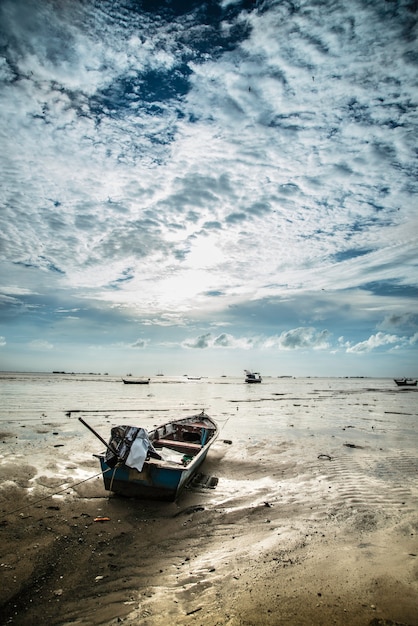
Similarly, coastal tourism, a major economic driver for many regions, relies heavily on healthy beaches, vibrant coral reefs, and thriving marine life. Sea-level rise and extreme weather events damage coastal infrastructure and natural attractions, deterring tourists and resulting in significant economic losses for local communities.
- Reduced Fish Stocks: Changes in ocean temperature and chemistry affect fish migration patterns, breeding success, and overall abundance.
- Damaged Resorts and Infrastructure: Coastal storms and erosion directly impact hotels, marinas, and other tourism-related facilities.
- Aesthetic Degradation: Bleached reefs, eroded beaches, and polluted waters diminish the appeal of coastal destinations.
The interconnectedness of these sectors means that environmental degradation quickly translates into socioeconomic hardship, urging communities to seek alternative livelihoods or undertake costly protective measures.
Displacement and Cultural Heritage Loss
As sea levels rise and extreme weather events intensify, many low-lying coastal communities face the daunting prospect of displacement. Relocation, whether forced or voluntary, leads to significant social disruption, loss of cultural ties to ancestral lands, and immense psychological stress.
Historical sites, indigenous burial grounds, and culturally significant landscapes located along the coast are also increasingly vulnerable to erosion and inundation. The loss of these tangible and intangible elements of cultural heritage represents an irreversible blow to identity and history for affected communities. The issue of climate migration is becoming more pressing in 2025, with internal displacements within countries like the US becoming more evident as coastal areas become uninhabitable.
The challenge extends beyond physical structures, encompassing the traditions, knowledge, and way of life that have been shaped by centuries of interaction with the coastal environment, highlighting the deep cultural value at stake.
Mitigation and Adaptation Strategies: Pathways Forward
Addressing the formidable challenges posed by the impact of climate change on coastal ecosystems requires a multi-faceted approach, combining robust mitigation efforts to reduce greenhouse gas emissions with strategic adaptation measures. While mitigation aims to slow down the rate of climate change globally, adaptation focuses on building resilience and reducing the vulnerability of coastal ecosystems and communities to unavoidable impacts.
The 2025 assessment underscores that neither strategy alone is sufficient. Integrated approaches that consider both human and natural systems are essential for fostering long-term sustainability and protecting invaluable coastal resources. Innovation and collaboration are key, transcending traditional boundaries of governance and scientific disciplines.
Harnessing Nature-Based Solutions
Nature-based solutions offer a powerful and often more cost-effective alternative to traditional “grey” infrastructure. These approaches leverage natural processes and ecosystems to provide coastal protection, enhance biodiversity, and sequester carbon.
- Restoring Wetlands and Mangroves: These ecosystems naturally attenuate waves, reduce storm surge, filter pollutants, and provide critical habitats.
- Rebuilding Coral Reefs: Efforts to restore degraded coral reefs can enhance marine biodiversity and provide natural breakwaters.
- Dune Restoration: Planting native vegetation on coastal dunes helps stabilize them and makes them more resilient to erosion.
These solutions not only offer ecological benefits but also often provide economic advantages by supporting fisheries, tourism, and improving overall environmental health. Investing in these ‘green’ infrastructure projects is a strategic move for future coastal resilience.
Policy Frameworks and Community Engagement
Effective climate action requires strong policy frameworks at local, national, and international levels. These policies must support emission reductions, enable responsible coastal development, promote sustainable resource management, and facilitate funding for adaptation projects.
Crucially, successful adaptation also depends on meaningful community engagement. Local residents, indigenous groups, and stakeholders possess invaluable traditional knowledge and are directly impacted by climate change. Their involvement in planning and implementing adaptation strategies ensures that solutions are culturally appropriate, equitable, and effective.
The 2025 landscape shows increasing recognition that top-down approaches are less effective than those that build capacity and empower local communities to lead their own resilience efforts, creating a shared vision for a sustainable coastal future.
The Path Ahead: Urgency and Collaboration
As we delve into 2025, the trajectory of climate change’s impact on coastal ecosystems presents a clear and urgent call to action. The assessment reveals that the challenges—from rising sea levels and ocean acidification to intensified extreme weather events—are not distant threats but unfolding realities. These impacts have far-reaching consequences, threatening biodiversity, disrupting critical ecosystem services, and imposing significant socioeconomic burdens on vulnerable coastal communities.
The degradation of vital habitats like coral reefs and mangroves, coupled with the erosion of shorelines, demands immediate and sustained attention. The interconnectedness of natural and human systems means that the health of coastal ecosystems directly correlates with the well-being and security of millions globally.
Moving forward, the emphasis must be on accelerating ambitious mitigation efforts while simultaneously scaling up robust adaptation strategies. This necessitates a profound shift towards greater investment in nature-based solutions, which offer resilient and sustainable alternatives to traditional infrastructure. Furthermore, strengthening policy frameworks and fostering genuine community engagement are paramount, ensuring that solutions are equitable, effective, and tailored to local contexts.
The scientific understanding of these challenges is continually advancing, providing clearer insights into the urgency of the situation. However, knowledge alone is insufficient. What is required is unprecedented collaboration across governments, scientific institutions, private sectors, and civil society. Only through concerted, coordinated action can we hope to safeguard the future of our invaluable coastal ecosystems and the communities that depend on them, transforming the daunting challenges of 2025 into opportunities for resilience and regeneration.
| Key Impact | Brief Description |
|---|---|
| 🌊 Sea-Level Rise | Accelerated erosion, habitat loss, and saltwater intrusion into freshwater systems, directly impacting coastal communities. |
| 🧪 Ocean Acidification | Decreased ocean pH hindering shell and skeleton formation for corals, shellfish, and other calcifying organisms. |
| ⛈️ Extreme Weather | Increased severity and frequency of storms, heatwaves, and flooding, causing widespread damage and ecosystem stress. |
| 📉 Biodiversity Loss | Species displacement, population declines, and disruption of critical marine food webs leading to ecosystem instability. |
Frequently Asked Questions
▼
Sea-level rise in the US is leading to increased sunny-day flooding, accelerated erosion, and saltwater intrusion into coastal aquifers. Low-lying areas in states like Florida and Louisiana are particularly vulnerable, experiencing direct impacts on infrastructure, freshwater supplies, and natural habitats, necessitating extensive adaptation measures.
▼
Ocean acidification primarily impacts organisms that form calcium carbonate shells and skeletons, such as oysters, clams, and certain species of plankton vital for the food chain. This leads to difficulties in growth, reproduction, and survival, threatening commercial fisheries and disrupting the marine ecosystem balance along US coastlines.
▼
Extreme weather events, like intensified hurricanes and heatwaves, cause severe physical damage to coastal habitats and infrastructure. Storm surges lead to extensive flooding and erosion, while marine heatwaves cause widespread coral bleaching and species die-offs, pushing ecosystems beyond their natural recovery capacity.
▼
Nature-based solutions, such as restoring wetlands, mangroves, and coral reefs, leverage natural processes to provide coastal protection. They absorb storm energy, filter pollutants, sequester carbon, and provide vital habitats, often being more cost-effective and ecologically beneficial than traditional “grey” infrastructure.
▼
Engaging local communities, including indigenous groups, ensures that adaptation strategies are culturally relevant, equitable, and effective. Local knowledge and direct experiences are invaluable for identifying vulnerabilities and developing practical, sustainable solutions that protect both the environment and the livelihoods of those most reliant on coastal resources.
Conclusion
The 2025 assessment of climate change’s impact on coastal ecosystems paints a clear picture of escalating threats and urgent needs. The intricate interplay of sea-level rise, ocean acidification, and extreme weather events is fundamentally reshaping our coastlines, jeopardizing invaluable biodiversity, and placing immense pressure on human communities. Our analysis reveals that these challenges are not just environmental; they are deeply intertwined with socioeconomic stability, cultural heritage, and the very fabric of coastal life. The path forward demands a dual commitment to aggressive global mitigation of greenhouse gases and robust, community-driven adaptation strategies. By embracing nature-based solutions, fostering international collaboration, and empowering local stakeholders, we can build more resilient coastal systems and ensure their vitality for generations to come. The urgency of 2025 is a definitive call to action, reminding us that collective effort is the only route to safeguarding these irreplaceable marine and coastal treasures.

